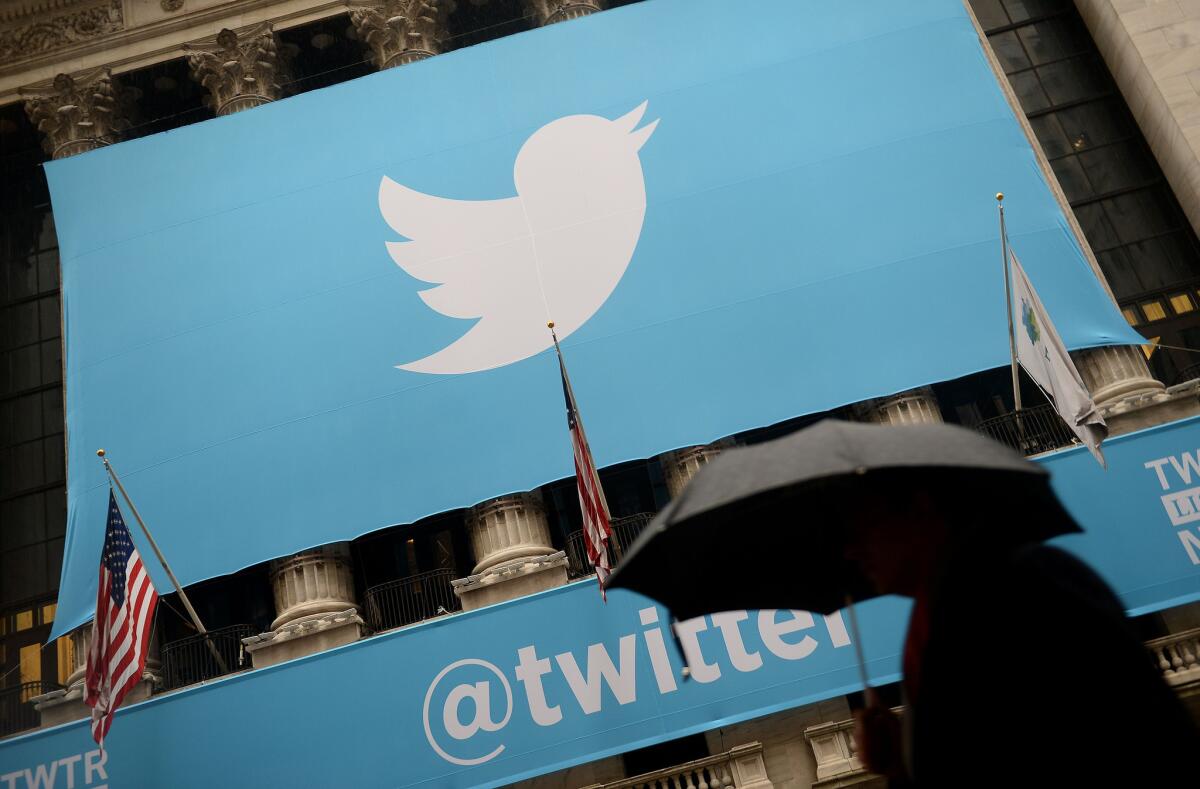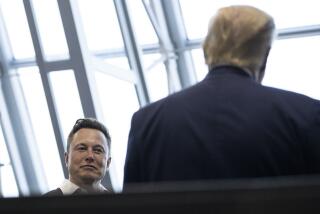If only Wall Street would let Twitter find its way

What really drives concerns about Twitter’s future is its relationship with Wall Street, which demands profits and growth from a company that’s still finding its way. Above, the Twitter logo at the New York Stock Exchange in 2013.
Cards on the table: I love Twitter.
Of all social media applications, it’s the one I spend the most time on — in fact, I’ve almost never been off it since I joined in April 2009. It’s the first application I check at the beginning of the day and the last before drifting off to sleep. I get column ideas, promote my work, and weigh in on others’. Users point me to interesting books and can’t-miss movies. It’s my early-warning system of developing events and a reliable gauge of what pundits and sages are thinking. There are also dog pictures.
So when people started tweeting that Twitter was dead or dying — using the hashtag “#RIPTwitter” —naturally I grew concerned. The drumbeat has been building since at least mid-2015 but has become especially thunderous since the San Francisco company announced its latest financial results Feb. 10. That’s when Twitter revealed that its most important metric, its monthly active users, had declined to 305 million in the last quarter of 2015 from 307 million in the previous quarter.
The decline rattled investors unaccustomed to social media companies shedding users. The stock opened the next morning with a loss of about 6%, but has since moved higher, closing at $17.94 on Friday. In part that was a response to Twitter executives’ assurances that the user count had shown a “rebound” since the first of the year and that it’s up 6% from the fourth quarter of 2014.
The real question about Twitter may be whether anything actually is fundamentally wrong with it. What really drives concerns about Twitter’s future is its relationship with Wall Street, which demands profits and growth from a company that’s still finding its way.
Twitter may be the quintessential company that should not have gone public in November 2013, at least not at its stage of development. As a private firm, it might have had more time to figure out who its users are and how best to serve them profitably; as a public corporation, it’s trapped by the need to find millions of new users and squeeze their attention span for profit, without alienating the old.
Meanwhile, Twitter loses an average of hundreds of millions of dollars a year, according to generally accepted accounting principles, or GAAP. It’s a rare public company that can sustain such a record; Amazon can rack up years of losses or razor-thin profits because investors have believed founder Jeff Bezos’ assurances that they’re in the name of long-term growth, but Twitter’s management may not have that luxury.
Executive instability hasn’t helped settle investors’ stomachs. Veteran management consultant Dick Costolo was dumped as CEO in June after five years at the helm and replaced by Jack Dorsey, a Twitter co-founder and former chairman; four top executives left last month as Dorsey overhauled the corporate suite. Since his return, Dorsey has been tinkering with Twitter’s platform, tweaking the order that tweets get shown to users, assembling them into newsy compilations called “Moments,” pushing more advertising. Some might even produce long-term growth, but the spotlight of public ownership leaves little room for experimentation or error.
Among all the services offering incremental variations on each other as social media, Twitter is unique. As a primer for the offline and uninitiated, Twitter allows you to send brief 140-character messages, or tweets, to your “followers” and receive them from those you follow. Tweets can include links to Web content, photos or other media; Twitter also is pondering messages much longer than 140 characters. The simplicity, immediacy and reach of this system has made it a must-have for journalists, politicians, publicists, celebrities (Katy Perry has 83.4 million followers) and corporations, which use Twitter to broadcast news almost instantaneously.
Twitter’s role as a hybrid personal/public communications space, essentially unmoderated, is both its virtue and its curse. Twitter has bound millions together in grand public events, such as the Egyptian revolution of 2011; but utter misinformation can go viral faster than facts, as happened after the 2013 Boston Marathon bombing.
Its ability to focus the attention of millions of unrelated users on a single target has been uniquely destructive to innocent people’s reputations. In 2013, a publicist for a New York media company tweeted out a joke about AIDS just before boarding a plane for her home in South Africa. The Twitterverse decided incorrectly that her tweet was racist, and she disembarked to learn that she had become the object of global condemnation in the 15 hours she was aloft.
Twitter has proved unable — or unwilling — to address the noxious invective that often pervades its traffic. Streams of misogynistic ranting and ideological invective have driven many women off the service, but efforts to curb it anger those who think their right to free speech is being infringed. Users provide all the content on Twitter and feel they’ve created a public space. But in reality it’s a commercial product run by corporate managers who want to attract the largest number of users to make money.
Twitter has tried to manage the inherent tension between free speech and good taste by imposing rules of behavior and ejecting users who violate them. Those rules are simultaneously detailed and nebulous and inevitably infuriate some users when they’re enforced.
Then there’s Twitter’s inability to define itself, a major drawback for a publicly traded company. During the company’s earnings conference call Feb. 10, one analyst asked Dorsey point-blank to describe Twitter’s identity: “There’s this constant question of how Twitter fits into the ecosystem versus your peers.... Is it social media, messaging, a lead-generation tool?”
Dorsey’s answer was less than coherent. “It’s powerful because it’s public, it’s powerful because — and sticky because of the conversations and the connections that emerge,” he said. “And then it can be everywhere because it’s distributed. And all of that adds up to us being the fastest.... Our focus is really what’s the most meaningful guide path into the experience? And then what really continues to engage people, and we think that’s around conversation and on to the next live event.”
Twitter’s basic dilemma was set forth by Kevin Landis, a fund manager and long-term Twitter owner, on CNBC the day of its latest earnings announcement. “The product is essential for those who tweet,” he said. “The product is not essential for those who simply check their Twitter feed.” Dorsey has been working to make it more relevant to the second group, but every tweak he proposes only enrages a large portion of the first group.
I understand that making more money is the key to Twitter’s survival. But after having spent almost seven years getting my Twitter feed arranged just as I like it, I also wish Dorsey had the patience to just leave it alone.
Michael Hiltzik’s column appears every Sunday. His new book is “Big Science: Ernest Lawrence and the Invention That Launched the Military-Industrial Complex.” Read his blog every day at latimes.com/business/hiltzik, reach him at [email protected], check out facebook.com/hiltzik and follow @hiltzikm on Twitter.
More to Read
Inside the business of entertainment
The Wide Shot brings you news, analysis and insights on everything from streaming wars to production — and what it all means for the future.
You may occasionally receive promotional content from the Los Angeles Times.











